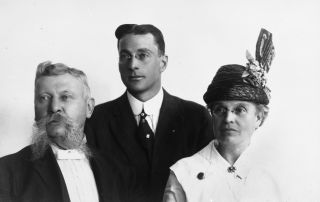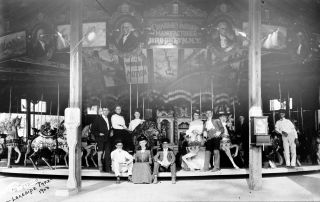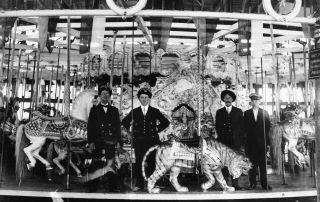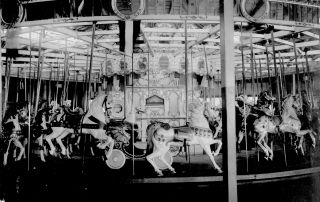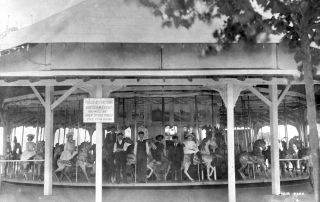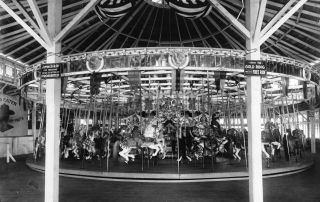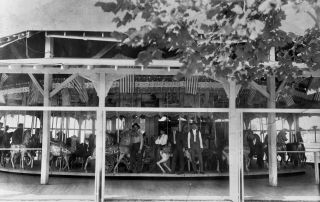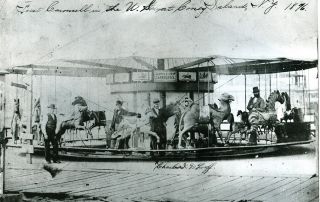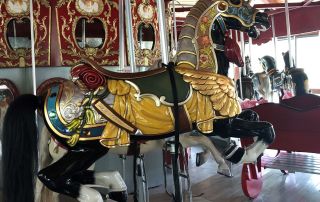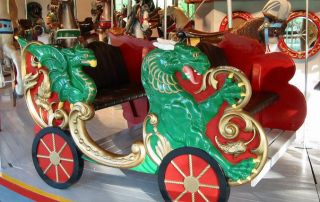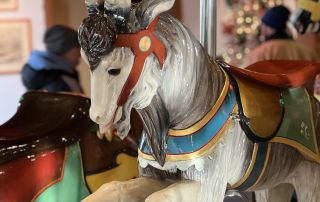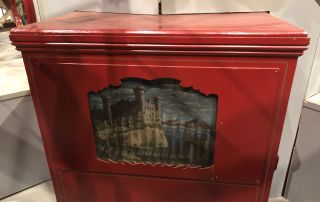The Story of Heritage’s Carousel
Carousel Update:
Our carousel is open for photo ops and exploring! Even though rides will not be available for the remainder of the main season, guests are welcome to come and sit on the horses and carriages for pictures and enjoy this rare opportunity to discover new details and features of this treasured amusement. Thank you for your patience and understanding.
No visit to Heritage is complete without seeing (and riding?!) Heritage’s beautiful 1908 Looff Carousel, housed in the American Art & Carousel Gallery. It has an uncanny way of bringing smiles. Not only is it beautiful and fun, but it also has quite the backstory. It was made in Riverside, Rhode Island by Charles I.D. Looff. Working in the late 1800s and early 1900s, Charles I.D. Looff was one of America’s best carousel makers.
All About Charles I.D. Looff, Master Carousel Maker
 In 1870, when he was eighteen, Looff immigrated from Denmark to Brooklyn, New York. A talented woodcarver, his first job was making furniture. Somehow, he convinced the owner of the amusement park at Coney Island, New York to let him install a carousel there. Working alone, Looff carved, painted and assembled his first carousel (and Coney Island’s first ride) in 1876. It was a huge success and Looff spent the rest of his life building carousels.
In 1870, when he was eighteen, Looff immigrated from Denmark to Brooklyn, New York. A talented woodcarver, his first job was making furniture. Somehow, he convinced the owner of the amusement park at Coney Island, New York to let him install a carousel there. Working alone, Looff carved, painted and assembled his first carousel (and Coney Island’s first ride) in 1876. It was a huge success and Looff spent the rest of his life building carousels.
Between 1876 and 1916, he built about forty carousels, first in Brooklyn and then, from a new factory in Riverside, Rhode Island. About ten Looff carousels are still in operation today, including this one.
Looff’s family got in the business too! His son, Charles, was known for carving saddles and chariots. His son, Arthur, made many amusement rides and roller coasters of his own.
Every carousel maker had their own style. Looff’s carousels are known for the highly decorated carving and ornamentation on the figures. Each one has a distinct personality, realistic features, glass eyes, and a real horse hair tail. Think sparkling mirrors, glittering jewels, and plenty of gold and silver highlights.
The Carousel Comes to Heritage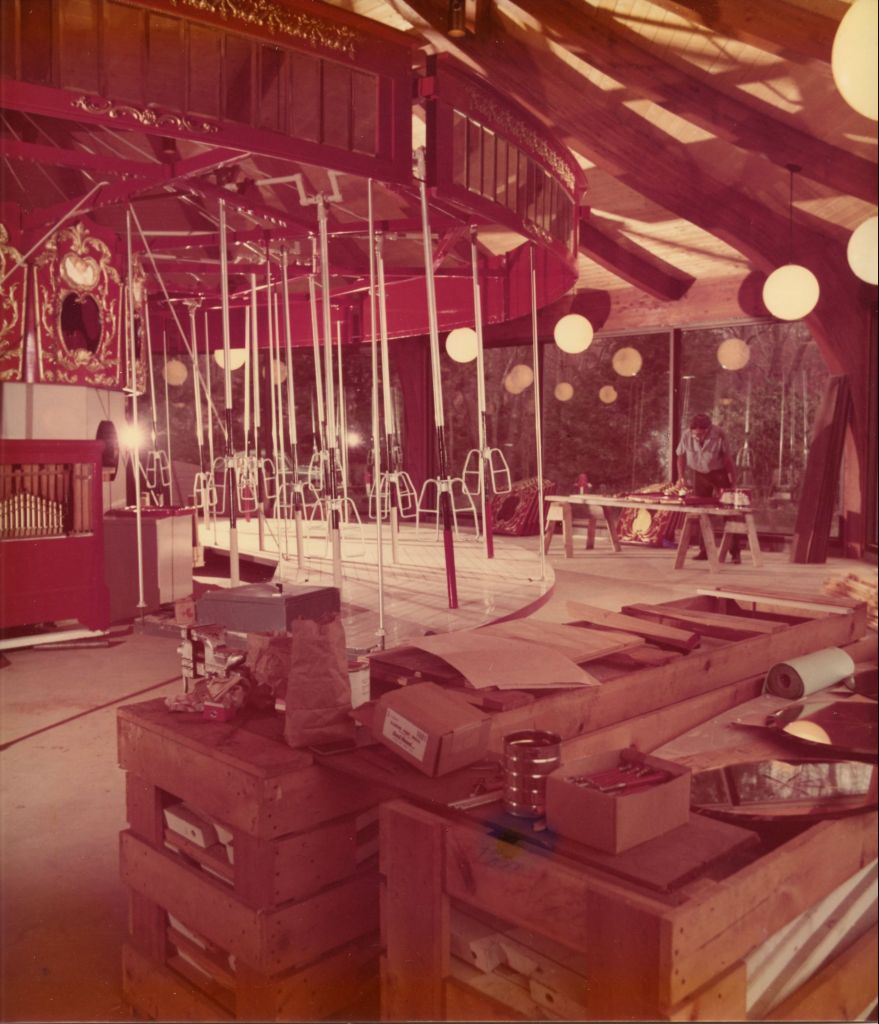
In 1908, this carousel was ordered by an amusement park in Mississippi. It was enjoyed by visitors there for decades but was eventually dismantled and listed for sale. The figures were purchased by a Cape Cod resident, but when he went to retrieve the platform in Mississippi, he found it rotted beyond repair. He bought a new platform, and planned to install the carousel in his backyard in Provincetown. The town would not allow this, so he sold the carousel to J.K. Lilly III for use at this museum. Mr. Lilly had the American Art & Carousel Gallery specially built to resemble a circus tent and the carousel opened to the public in 1972.
Restoration
The carousel has been well-maintained by Heritage’s staff for over fifty years. The oldest horses on this carousel were carved in the 1880s, which makes them about 140 years old! Several years ago the museum embarked on an Adopt-A-Horse program to restore the figures, which had all been stripped and repainted in the 1970s. The process is slow and meticulous with one to two horses completed each year. Each figure is carefully stripped of paint, properly repaired (as needed), and then repainted as if fresh from Charles Looff’s shop.
Thank you to our friends at CarouselHistory.com for sharing some images of the Looff Family & their amazing creations.
To learn more about Looff, please click here.
Special Features of Heritage’s Carousel
Heritage’s carousel is an excellent example of Looff’s craftsmanship and style.
- The word carousel has been traced to 12th century Arabian games of horsemanship called carosellos (Italian for “little wars”). Introduced to Europe by Spanish and Italian crusaders, the contests were tests of equestrian skill involving real horses and riders moving in a circle.
- The earliest forms of carousels were turned by people, mules or horses! (usually in a pit underneath the carousel). In 1832, a system of gears allowed a person to stand in one place and turn a crank. In 1860, the steam engine was adapted to power carousels in England. Electricity started powering carousels around the early 1900s.
- Carousels were most popular in America in the late 1800s and early 1900s. As the country became increasingly urbanized in the late 1800s, lake and oceanside parks sprang up offering a respite from hot and crowded cities. As the parks grew, attractions like carousels were added to entertain their visitors.
- In the early 1900s, there were A LOT of carousels! There were about 2,000 carousels made in America between 1885 and 1925, only about 130 of which survive today. Many were destroyed by fires, hurricanes and other disasters. Others suffered the fate of many small, family-owned amusements that could not compete with corporate theme parks and rising labor prices. In addition, television and video games and the added comfort of air-conditioning made indoor diversions more appealing and popular.
- From 1885 to 1940, the standard price of a carousel ticket was five cents.
- What’s the difference between a merry-go-round and a carousel? Nothing!
Interested in learning more? Click here!
Generations of Memories
With over 5 million visitors since this antique carousel began operating at Heritage in 1972 (and countless more since its creation in 1908!) our horses have seen some wear and tear over the years. Fortunately, our carousel horses are on a rotational visit to restoration artist James Hardison’s workshop in Hull, MA.


